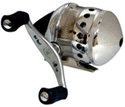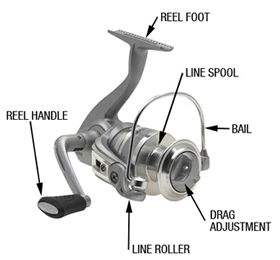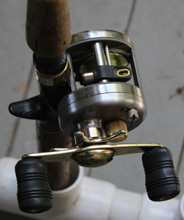FISHING EQUIPMENT
First and foremost, the most important part of fishing is HAVING FUN! Catching fish is secondary to the opportunity to spend quality time with family and friends and taking the time to enjoy the beauty of nature and the fresh air. At a time when so much entertainment is derived from video games, TV, and computers, fishing can offer a refreshing reprieve from this screen time. Keep the atmosphere light and relaxed and be sure to enjoy the outdoors!
FISHING RODS AND REELS
POWER AND ACTION
Rods come in different "powers." Power describes the amount of strength a rod provides. Rods may be classified as Ultra-Light, Light, Medium-Light, Medium, Medium-Heavy, Heavy, Ultra-Heavy, or other similar combinations. The Power of a rod is matched to the type of fishing, species of fish, or size of fish. For instance, ultra-light rods are suitable for catching panfish or bass, where rod responsiveness is critical. Heavy rods are used for large muskie. Ultra-heavy are typically only used in deep sea fishing. A good general purpose rod is one rated as Medium.
Action" refers to the speed with which the rod returns to its neutral position. An action may be slow, medium, fast, or anything in between (e.g. medium-fast.) The action will influence how far an angler can cast, the responsiveness when a fish takes a hook, and the action felt when reeling the fish in.
Types of Fishing Rods and Reels
Spincasting reels offer the most simplistic design and therefore are the easiest to use. They're also the least expensive. However, they generally come at the cost of reduced cast length relative to other types of reels.
This is an excellent reel for young children or the beginning angler.
Spinning reels are preferred by many people as a compromise between ease of use, cost, and cast length. They are preferred when casting lighter lures/sinkers.
Spinning rods position the reel on the underside of the rod. Guides are large and taper in size toward the tip to facilitate casting. Generally, there are more guides on a spinning rod than a spincasting rod. Lengths vary greatly from under 5 feet to over 10 feet for specialized fishing. Price depends on components, but inexpensive spinning rods can be purchased from many retailers and sporting goods stores.
Spinning or fixed spool reels are mounted below the rod; this positioning conforms to gravity, requiring little wrist strength to maintain the reel in position. The spinning rod is held and cast by the stronger hand, leaving the other hand free to operate the crank handle.
These fixed spool reels are cast by opening the bail, grasping the line with the forefinger, and then using a backward snap of the rod followed by a forward cast while releasing the line with the forefinger at the same time. The crank handle is then rotated to flip the bail and to stop the flow of the line.
Baitcasting reels are the most difficult to master and are used in situations where you are targeting larger fish or using heavy lures/sinkers. They're also preferred when casting accuracy and control are needed.
Baitcasting rods are similar to spincasting rods, placing the reel on top and incorporating small guides that taper in size as you move toward the tip. There are often many guides on a baitcasting rod to give an angler more control when casting. Like spinning rods, price depends on components, but inexpensive baitcasting rods can be purchased from many retailers and sporting goods stores.
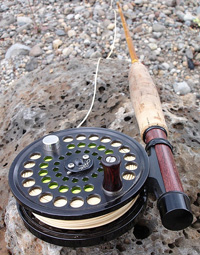 Fly fishing is a method of fishing using an artificial "fly." The fly is cast using a fly rod, reel, and specialized weighted line. Casting a nearly weightless fly or "lure" requires casting techniques significantly different from other forms of casting. In spin casting, the weight of the lure pulls the line off the reel. In fly casting, the weight of the line carries the fly to the fish so the fly rod becomes a lever or extension of your arm to case the line.
Fly fishing is a method of fishing using an artificial "fly." The fly is cast using a fly rod, reel, and specialized weighted line. Casting a nearly weightless fly or "lure" requires casting techniques significantly different from other forms of casting. In spin casting, the weight of the lure pulls the line off the reel. In fly casting, the weight of the line carries the fly to the fish so the fly rod becomes a lever or extension of your arm to case the line.
Fly fishing is most commonly associated with trout fishing however it has gained popularity with anglers fishing from everything from largemouth bass and bluegill to big-game saltwater species.
Fly rods come in various weights for the purpose of casting a particular weight line. The size number of the fly rod is directly tied to the size or number of the fly line intended to be cast. A larger fly (lure) requires a heavier line, which uses a heavier weight rod.
A 3-weight rod will ideally cast a 3-weight line. An 8-weight rod will ideally cast an 8-weight line. The bigger the number, the larger the rod and the heavier the line the rod will cast.
When the fly is too heavy for the line, the line sags and the cast doesn't make it. The size of the fly you want to use determines the size of the line that will properly cast it. For general freshwater fishing for Illinois species a 6 or 7 weight rod and line will work nicely. As you become more sophisticated, you can add larger or smaller weight rods to tailor you fishing experience to trout, crappie, bass, carp, etc.
Start with a mid-weight (5 or 6 weight) fly rod, fly line of the same weight, and fly reel. Look for a beginner's package with a rod, reel, weight-forward floating line, and leader. Kits are available at sporting goods stores and can work well. Specialty fly shops offer beginner setups in a range of prices and provide helpful advice.
FISHING LINE
Line comes in different "pound tests." Pound test refers to the amount of weight it takes to break the line. Generally, it's best to choose a line that has a pound test breaking strength above the maximum size fish you would expect to catch. For most lakes in Illinois, 8-14 pound test is a good place to start.
The most common, least expensive, and most accessible line is monofilament. It is good for beginners because it is easy to manipulate. In general, monofilament is a good all-around choice.
Braided line offers no-stretch capabilities, unlike monofilament that has some inherent stretch. Braided line is used when fishing locations with heavy, abrasive cover such as sharp rocks, wood, or near metal structures in the water. It is thinner in diameter so you can use higher pound test line and put more on the reel.
Fluorocarbon line has little stretch, similar to braided line, and contains properties that make it almost invisible in the water. It is generally reserved for fishing very clear water.
Fly Line * Leader * Tippet: Fly line is heavier and thicker than monofilament line. It's covered with plastic so that it floats on the water. The weight of the fly line propels the fly forward during the cast.
A piece of clear monofilament line called a leader connects the fly line to the fly. The leader is less visible to fish than the fly line. And, because it's lighter, it splashes less on the water.
The leader is tapered, thicker where it attaches to the fly line and thinner where it connects to the fly. The thinner end of the leader is called the tippet. As you tie on new flies the tippet gets shorter. When this happens you can tie on new tippet material.
 PROPER LINE DISPOSAL
PROPER LINE DISPOSAL
As a reminder to all anglers, the improper use and disposal of fishing line can have a dramatic impact on our wildlife. Inappropriately discarded monofilament often accumulates in popular fishing areas and may tangle around boat propellers and aquatic life, while taking over 500 years to decompose. This poses threats to fishermen, the fish they catch and important fish habitat and breeding grounds. Abandoned line can "ghost fish" by continuing to catch aquatic species (e.g., fish, turtles and birds) in makeshift nets for many years.
As a reminder to all anglers, the improper use and disposal of fishing line can have a dramatic impact on our wildlife. Many shore birds, migratory birds, waterfowl and raptors have become entangle in monofilament and died.
Please help reduce the risk of wildlife-related mortalities due to monofilament by:
- Properly dispose of unused monofilament in trash containers.
- Use the appropriate test line for the desired fish and fishing technique
- Replace monofilament yearly to reduce the chance of breaking the line.
- Take the initiative while enjoying Illinois waters — pick up any discarded monofilament and tackle you see along the shore.
Promote the use of Monofilament recycling bins and encourage the collection and recycling of monofilament line. The Berkley Conservation Institute provides a recycling service and has recycled more than 9 million miles of fishing line since 1990. Anglers can mail used monofilament line directly to Berkley's collection center at: Berkley Recycling, 1900 18th Street, Spirit Lake, IA 51360.
TERMINAL TACKLE
 HOOKS come in a wide array of designs and sizes. Small "Aberdeen" hooks are very common and typically used with live-bait such as worms or wax worms. Treble hooks are often used with artificial lures such as crankbaits or topwaters, but can also be used to hook minnows or large worms. Other hooks are specifically designed for certain types of lures or to reduce the chances of deep-hooking a fish (e.g., circle hooks). Hooks have a barb on the inside of the point, which makes it difficult for a fish to "throw the hook."
HOOKS come in a wide array of designs and sizes. Small "Aberdeen" hooks are very common and typically used with live-bait such as worms or wax worms. Treble hooks are often used with artificial lures such as crankbaits or topwaters, but can also be used to hook minnows or large worms. Other hooks are specifically designed for certain types of lures or to reduce the chances of deep-hooking a fish (e.g., circle hooks). Hooks have a barb on the inside of the point, which makes it difficult for a fish to "throw the hook."
SINKERS add weight to your line, helping the bait or lure to sink to the bottom or a distance below the surface. Weights come in different varieties including, among others, split shot weights that clamp to your line and egg sinkers and bullet sinkers that slide up and down your line. Match the weight size to the depth you are fishing — in shallow water use lighter sinkers and in deeper water use heavier sinkers.
SWIVELS have two ends where you tie your line. One end is tied directly to your main line and another piece of line with your bait or lure is tied to the other end. A snap swivel is similar, but has only one end where you tie your line and on the other end a built-in snap (clasp) is affixed that connects to your lure.
LURES AND BAITS
Artificial lures are designed to mimic fish, insects, and other aquatic organisms that live in or around water. They can, at times, be as effective as or more effective than bait. Lures require the angler to impart the action and are more of hands-on than bait. Lures are generally broken up into the following groups:
Soft Plastics — These lures are designed to closely resemble food that many fishes eat. They can be rigged a number of ways and come in many different sizes for mimicking certain types of food depending on the species being targeted.

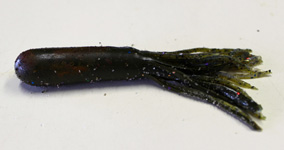
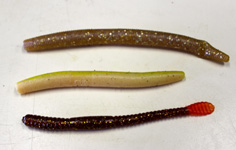
Crankbaits — These lures are designed to mimic small baitfish or sometimes small crustaceans and insects. Characteristic of this group of lures is a small plastic bill at the front of the lure that creates drag as the lure is pulled through the water and thus causes it to dive. The larger the lip, the deeper a crankbait will dive. These are very easy lures to use as they simply require the angler to cast it out and reel it in.
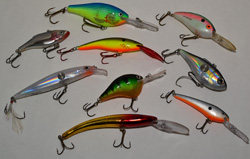
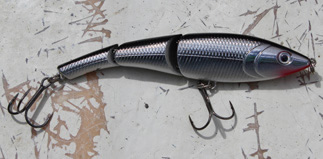
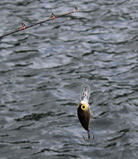
Note the variety of Crankbaits available. Some mimic the colors of other fish, while others have bright colors that serve as attractors. Jointed crankbaits simulate a baitfish in distress as the lure is pulled through the water. Deep-diving crankbaits, like the one at right, have a large front lip and will go down to deeper water for walleye and pike.
Spinners and Spinnerbaits — A spinner is often referred to as a lure with a blade that spins directly in-line with the rest of the lure. A spinnerbait is a lure with a length of wire protruding from the front of a weight where the wire is bent and the blades attached near the bend. Both spinners and spinnerbaits are also very easy to use requiring the angler to just cast out and reel in.


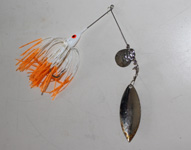
Topwaters — Topwater lures are those that float on the water's surface, the exception being some that sink and require one to reel them to the surface. Fish will strike the lure as it sits or is slowly reeled on the surface, often creating exciting explosions.
Topwaters come in a variety of different shapes to impart different actions, and may require the angler to move their rod and crank their reel in specific manners to achieve a desired action.

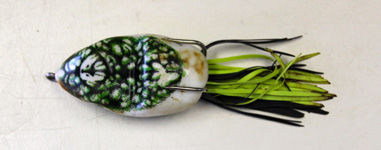
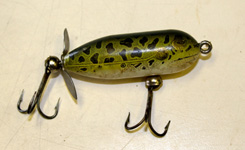
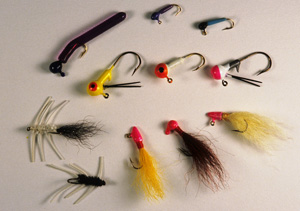
Jigs — A jig is most often simply a lead or tungsten weight of various shapes molded onto the front of a hook. A soft plastic lure is then threaded onto the hook. Sometimes a silicon skirt will be positioned just below the jig head, adding bulk and extra action to the lure.
Using bait — be it alive or dead — often increases your chances of catching a fish.
 Worms (a.k.a. nightcrawlers) — work best for bluegills, pumpkinseeds, green sunfish, largemouth bass, and catfish. Worms can be bought at tackle or bait shops, Walmart, Dicks, and other sporting goods stores. Use ½ or ⅓ of a worm for best results. Thread part of the worm on the hook, being sure to leave some of it hanging off to wiggle enticingly. See below for rigging options.
Worms (a.k.a. nightcrawlers) — work best for bluegills, pumpkinseeds, green sunfish, largemouth bass, and catfish. Worms can be bought at tackle or bait shops, Walmart, Dicks, and other sporting goods stores. Use ½ or ⅓ of a worm for best results. Thread part of the worm on the hook, being sure to leave some of it hanging off to wiggle enticingly. See below for rigging options.
Wax worms — These work best for bluegills, crappies, green sunfish. Because of their small size, use a whole wax worm or even 2-3 on the same hook. See below for rigging options.
Minnows — These work best for crappie, largemouth bass, white bass, walleye. Minnows should be kept alive (kept in a bait-bucket filled with water) for best results, but some retailers sell dead minnows in packages.
In flyfishing, the flies are meant to imitate the size, color and patterns that best match local terrestrial and aquatic insects, baitfish, leeches and worms attractive to the type of fish you're trying to catch.
 Dry flies float on the water's surface and imitate a wide range of foods, including adult mayflies, caddis flies, midges, grasshoppers, crickets and ants.
Dry flies float on the water's surface and imitate a wide range of foods, including adult mayflies, caddis flies, midges, grasshoppers, crickets and ants.
Wet flies, or nymphs, represent the immature life stages of insects such as mayflies and caddis flies, and are fished below the water's surface.
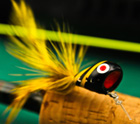 Streamers represent minnows, leeches and other swimming food items that provide meals for bass, trout, panfish.
Streamers represent minnows, leeches and other swimming food items that provide meals for bass, trout, panfish.
Poppers flies are larger and they considered a surface fly. When used in freshwater can imitate frogs, big bugs, or baitfish.
Fly sizes are referred to by a number that relates to the size of the hook. For dry flies, the larger the number, the smaller the fly. A size 22 is smaller than a size 16.
FISHING TOOLS
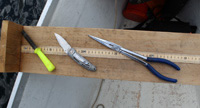
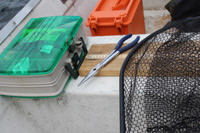
The well-stocked angler has their tools handy for a day of catching fish.
- Tackle Box
- Pliers
- Net
- Measuring Board
- Hook Sharpener
- Knife or Nail Clippers
- Stringer
- Polaroid Sunglasses
Helpful items to bring along:
- Sunscreen
- Bug Spray
- First Aid Kit


